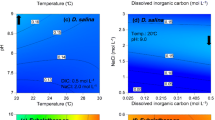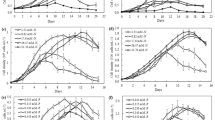Abstract
Four green microalgae (Chlorella sorokiniana, Chlorella vulgaris, Scenedesmus obliquus and Selenastrum capricornutum), a wild Bolivian microalga strain and two cyanobacteria (Anabaena catenula and Microcystis aeruginosa) were compared for tolerance to salicylate, O2 production capacity and ability to support salicylate degradation by a Ralstonia basilensisstrain in symbiotic microcosms with the microalgae. Microcystis aeruginosa had the highest tolerance to salicylate at 500 mg l−1 and 1500 mg l−1 but only produced 0.7 mg O2 l−1 h−1 in the absence of pollutant. Chlorella sorokiniana resisted salicylate at 1500 mg l−1 with the highest O2 production in the absence of salicylate (26 mg l−1 h−1) closely followed by the Bolivian microalga (23 mg l−1 h−1) and Chlorella vulgaris (21 mg l−1 h−1). Selenastrum capricornutum and Anabaena catenula were completely inhibited by salicylate at 500 mg l−1. When inoculated with Ralstonia sp. and supplied with salicylate, Chlorella sorokiniana had the highest removal rate (19 mg l−1 h−1), followed by the wild Bolivian strain (18 mg l−1 h−1) and Chlorella vulgaris (14 mg l−1 h−1).
Similar content being viewed by others
References
Aiba S (1982) Growth kinetics of photosynthetic microorganisms. Adv. Biochem. Eng. 2: 85–156.
Baker KH, Herson DS (1978) Interactions between the diatom Thallasiosira pseudonanna and an associated Pseudomonad in a mariculture system. Appl. Environ. Microbiol. 35: 791–796.
Bell J, Melcer H, Monteith H, Osinga I, Steel P (1993) Stripping of volatile organic compounds at full-scale municipal wastewater treatment plants. Water Environ. Res. 65: 708–716.
Borde X (2001) Association synergique de bactéries et d'une microalgue verte pour la biodegradation de polluants aromatiques modèles dans des cultures batch et continues. Ph.D. Thesis, Rennes, France: Rennes University.
Borde X, Guieysse B, Delgado O, Muñoz R, Hatti-Kaul R, Nugier-Chauvin C, Patin, H, Mattiasson B (2003) Synergistic relationships in algal-bacterial microcosms for the treatment of aromatic pollutants. Bioresour. Technol. 86: 293–300.
Dakhama A, De la Noüe J, Lavoie MC (1993) Isolation and identification of antialgal substances produced by Pseudomonas aeruginosa. J. Appl. Phycol. 5: 297–306.
De-Bashan LE, Bashan Y, Moreno M, Lebsky V, Bustillos JJ (2002) Increased pigment and lipid content, lipid variety, and cell and population size of the microalgae Chlorella spp. when co-immobilized in alginate beads with the microalgae-growthpromoting bacterium Azospirillum brasilense. Can. J. Microbiol. 48: 514–521.
Guieysse B, Borde X, Muñoz R, Hatti-Kaul R, Nugier-Chauvin C, Patin H, Mattiasson B (2002) Influence of the initial composition of algal-bacterial microcosms on the degradation of salicylate in a fed-batch culture. Biotechnol. Lett. 24: 531–538.
Guieysse B, Cirne MDTG, Mattiasson B (2001) Microbial degradation of phenanthrene and pyrene in a two-liquid phase partitioning bioreactor. Appl. Microbiol. Biotechnol. 56: 796–802.
Haines KC, Guillard RRL (1974) Growth of vitamin B12-requiring marine diatoms in mixed laboratory cultures with vitamin B12-producing marine bacteria. J. Phycol. 10: 245–252.
Martinez M, Molina E, Garcia F (1995) Influencia de la intensidad de iluminacion en la composicion bioquímica de la microalga marina Tetraselmis sp. Afinidad LI. 459: 359–362.
Mouget JL, Dakhama A, Lavoie MC, De la Noüe J (1995) Algal growth enhancement by bacteria: is consumption of photosynthetic oxygen involved? FEMS Microbiol. Ecol. 18: 34–44.
Muñoz R, Guieysse B, Mattiasson B (2003) Phenanthrene biodegradation by an algal-bacterial consortium in two-phase partitioning bioreactors. Appl. Microbiol. Biotechnol. 61: 261–267.
Oswald JW (1988) Phototrophic microalgae and waste-water treatment. In: Borowitzka MA, Borowitzka LJ, eds. Micro-Algal Biotechnology. Cambridge: Cambridge University Press, pp. 305–328.
Rippka R, Deruelles J, Waterbury JB (1979) Genetic assignment strain history and properties of pure cultures of cyanobacteria. J. Gen. Microbiol. 111: 1–61.
Skulberg OM (2000). Microalgae as a source of bioactive molecules-experience from cyanophyte research. J. Appl. Phycol. 12: 341–348.
Sorokin C, Krauss RW (1958) The effect of light intensity on the growth rate of green algae. Plant. Physiol. 33: 1315–1320.
Wolfaardt GM, Lawrence JR, Robarts RD, Caldwell DE (1994) The role of interactions, sessile growth, and nutrient amendments on the degradative efficiency of a microbial consortium. Can. J. Microbiol. 40: 331–340.
Author information
Authors and Affiliations
Corresponding author
Rights and permissions
About this article
Cite this article
Muñoz, R., Köllner, C., Guieysse, B. et al. Salicylate biodegradation by various algal-bacterial consortia under photosynthetic oxygenation. Biotechnology Letters 25, 1905–1911 (2003). https://doi.org/10.1023/B:BILE.0000003980.96235.fd
Issue Date:
DOI: https://doi.org/10.1023/B:BILE.0000003980.96235.fd




